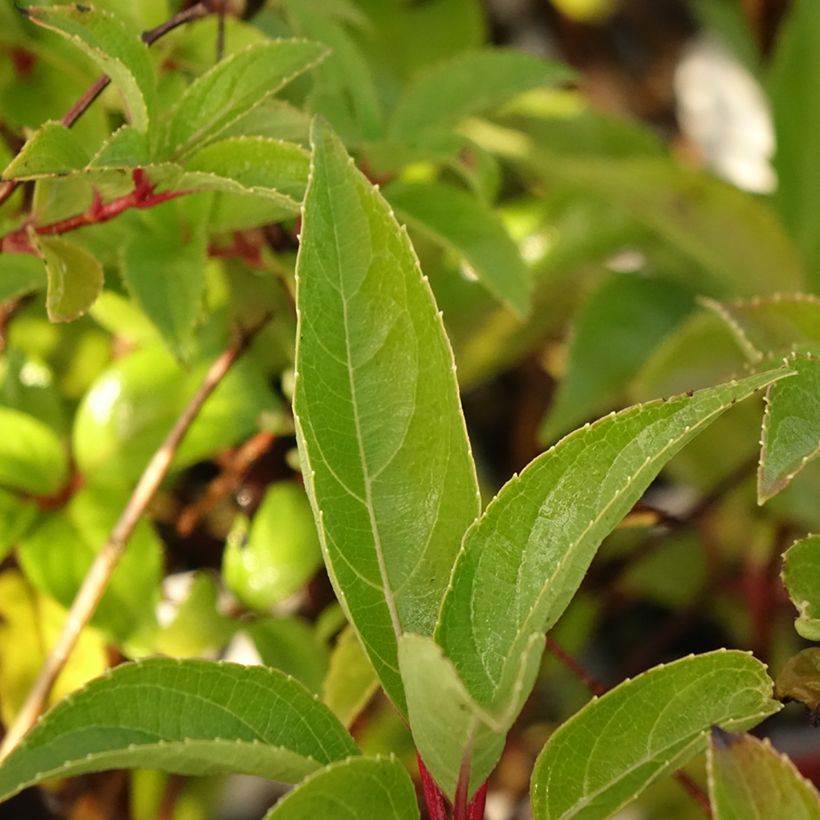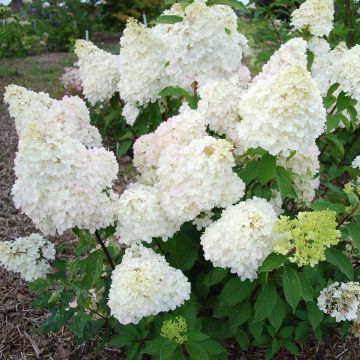

Hydrangea paniculata Dharuma


Hydrangea paniculata Dharuma
Hydrangea paniculata Dharuma
Hydrangea paniculata Dharuma
Paniculate Hydrangea, Panicled Hydrangea, Panicle Hydrangea
This item cannot be shipped to the selected country
Delivery charge from €5.90
Delivery charge from €5.90
More information
Schedule delivery date,
and select date in basket
This plant carries a 24 months recovery warranty
More information
We guarantee the quality of our plants for a full growing cycle, and will replace at our expense any plant that fails to recover under normal climatic and planting conditions.
From €5.90 for pickup delivery and €6.90 for home delivery
Express home delivery from €8.90.
From €5.90 for pickup delivery and €6.90 for home delivery
Express home delivery from €8.90.
Does this plant fit my garden?
Set up your Plantfit profile →
Description
Hydrangea paniculata 'Dharuma' is a variety of paniculate hydrangea with a compact habit that can be grown in large pots. Highly ramified and very dense, it is distinguished by its particularly early summer flowering. Its inflorescences in flat heads are pure white, before turning pink during the summer. Accommodating in terms of soil, it does not require heath soil to grow but is satisfied with a neutral or even slightly limestone soil, as long as it remains slightly humid in the summer season. Very hardy, it is the ideal hydrangea for beginner gardeners.
Hydrangea paniculata, also called Paniculate Hydrangea, is a particularly hardy species of hydrangea belonging to the Hydrangeaceae family native to deciduous forests of China and Japan. It is easy to grow in any good garden soil that remains fresh. In the past, there were only large varieties, but breeders have worked a lot on this species to introduce many compact cultivars. In the 1970s, the botanist Jelena de Belder introduced the Pink Diamond variety, which quickly caused a sensation with its white flowers that change colour during flowering.
The 'Dharuma' variety is renowned among paniculate hydrangeas, as it is one of the earliest to flower. Its medium-sized flat inflorescences (about 10 cm (3.9 in) in diameter) appear from mid-June. They are made up of narrow fertile flowers, grouped in the centre, and sterile flowers with four sepals which appear to float like butterflies on the periphery. This very graceful quality, found in some Viburnums, gives the plant a very romantic presence. Very compact, 1.2 m (3 ft 11 in) high for a width of about 1 m (3 ft 4 in), this shrub has a very regular habit thanks to its very dense branching. Its deciduous foliage of medium green, composed of elongated leaves that are pointed at their ends, sometimes changes colour in autumn before falling. This hydrangea tolerates partial shade but not complete shade. Its hardiness is very good, down to -25 °C (-13 °F).
Hydrangea paniculata 'Dharuma' is the ideal hydrangea for all gardeners frustrated at not being able to plant Hydrangea macrophylla, due to lack of suitable soil and climate. This hydrangea holds up very well in the sun, which is a definite advantage for this category of shrubs. Its small growth allows it to be grown in large pots on a terrace. Hydrangea paniculata will be appreciated for its long flowering period, which can even be extended as dried bouquets. In the garden, it can be planted with a wide range of shrubs flowering at other times. A Hamamelis 'Arnold Promise' will start the show with its yellow winter flowers, followed in late winter by a Japanese quince or the little-known Abeliophyllum distichum, resembling the popular forsythias, but with white flowers. Spring offers a plethora of choices, from the classic Van Houtte's Spiraea to the many weigelias. To accompany our hydrangea during the summer, there is nothing better than a Lagerstroemia, and to enjoy a contrast of foliage, the golden decoration of Leycesteria formosa Golden Lanterns (Pheasant Berry) will be perfect. And to finish off the cycle, nothing beats decorative fruits for the autumn and winter, like those of the snowberries.
Report an error about the product description
Hydrangea paniculata Dharuma in pictures


Plant habit
Flowering
Foliage
Botanical data
Hydrangea
paniculata
Dharuma
Hydrangeaceae
Paniculate Hydrangea, Panicled Hydrangea, Panicle Hydrangea
Cultivar or hybrid
Other Hydrangea Paniculata
Planting and care
Hydrangea paniculata Dharuma is not very demanding in terms of the nature of the soil, provided it is not too heavy. It does not require heath soil but will grow in neutral soil and even tolerates a bit of limestone. It also accommodates sandy or rocky terrain as long as it remains a little fresh, or if well watered. In such conditions, it is recommended to add compost to the base of the shrub each year.
It requires a sunny, non-scorching or semi-shaded exposure. When planting, install it in a deeply worked soil, after having soaked the root ball for half an hour in a bucket of water. A good base fertiliser (horn or dried blood) will aid the recovery of your young plant and nourish it without risk of burning. If your soil tends to be dry, mix compost with the soil, filling in the planting hole, and provide a watering basin on the surface.
At the end of summer, we advise you not to cut the dry panicles which will protect the terminal shoots of the branches in winter. You should cut all the dry flowers at the end of February or on the first summer days and remove some branches by cutting them very short each year in order to promote the growth of new shoots. Due to its limited development, this Hydrangea can also be grown in a container. In this case, remember to water regularly to prevent any drying out of the substrate.
Planting period
Intended location
Care
This item has not been reviewed yet - be the first to leave a review about it.
Haven't found what you were looking for?
Hardiness is the lowest winter temperature a plant can endure without suffering serious damage or even dying. However, hardiness is affected by location (a sheltered area, such as a patio), protection (winter cover) and soil type (hardiness is improved by well-drained soil).

Photo Sharing Terms & Conditions
In order to encourage gardeners to interact and share their experiences, Promesse de fleurs offers various media enabling content to be uploaded onto its Site - in particular via the ‘Photo sharing’ module.
The User agrees to refrain from:
- Posting any content that is illegal, prejudicial, insulting, racist, inciteful to hatred, revisionist, contrary to public decency, that infringes on privacy or on the privacy rights of third parties, in particular the publicity rights of persons and goods, intellectual property rights, or the right to privacy.
- Submitting content on behalf of a third party;
- Impersonate the identity of a third party and/or publish any personal information about a third party;
In general, the User undertakes to refrain from any unethical behaviour.
All Content (in particular text, comments, files, images, photos, videos, creative works, etc.), which may be subject to property or intellectual property rights, image or other private rights, shall remain the property of the User, subject to the limited rights granted by the terms of the licence granted by Promesse de fleurs as stated below. Users are at liberty to publish or not to publish such Content on the Site, notably via the ‘Photo Sharing’ facility, and accept that this Content shall be made public and freely accessible, notably on the Internet.
Users further acknowledge, undertake to have ,and guarantee that they hold all necessary rights and permissions to publish such material on the Site, in particular with regard to the legislation in force pertaining to any privacy, property, intellectual property, image, or contractual rights, or rights of any other nature. By publishing such Content on the Site, Users acknowledge accepting full liability as publishers of the Content within the meaning of the law, and grant Promesse de fleurs, free of charge, an inclusive, worldwide licence for the said Content for the entire duration of its publication, including all reproduction, representation, up/downloading, displaying, performing, transmission, and storage rights.
Users also grant permission for their name to be linked to the Content and accept that this link may not always be made available.
By engaging in posting material, Users consent to their Content becoming automatically accessible on the Internet, in particular on other sites and/or blogs and/or web pages of the Promesse de fleurs site, including in particular social pages and the Promesse de fleurs catalogue.
Users may secure the removal of entrusted content free of charge by issuing a simple request via our contact form.
The flowering period indicated on our website applies to countries and regions located in USDA zone 8 (France, the United Kingdom, Ireland, the Netherlands, etc.)
It will vary according to where you live:
- In zones 9 to 10 (Italy, Spain, Greece, etc.), flowering will occur about 2 to 4 weeks earlier.
- In zones 6 to 7 (Germany, Poland, Slovenia, and lower mountainous regions), flowering will be delayed by 2 to 3 weeks.
- In zone 5 (Central Europe, Scandinavia), blooming will be delayed by 3 to 5 weeks.
In temperate climates, pruning of spring-flowering shrubs (forsythia, spireas, etc.) should be done just after flowering.
Pruning of summer-flowering shrubs (Indian Lilac, Perovskia, etc.) can be done in winter or spring.
In cold regions as well as with frost-sensitive plants, avoid pruning too early when severe frosts may still occur.
The planting period indicated on our website applies to countries and regions located in USDA zone 8 (France, United Kingdom, Ireland, Netherlands).
It will vary according to where you live:
- In Mediterranean zones (Marseille, Madrid, Milan, etc.), autumn and winter are the best planting periods.
- In continental zones (Strasbourg, Munich, Vienna, etc.), delay planting by 2 to 3 weeks in spring and bring it forward by 2 to 4 weeks in autumn.
- In mountainous regions (the Alps, Pyrenees, Carpathians, etc.), it is best to plant in late spring (May-June) or late summer (August-September).
The harvesting period indicated on our website applies to countries and regions in USDA zone 8 (France, England, Ireland, the Netherlands).
In colder areas (Scandinavia, Poland, Austria...) fruit and vegetable harvests are likely to be delayed by 3-4 weeks.
In warmer areas (Italy, Spain, Greece, etc.), harvesting will probably take place earlier, depending on weather conditions.
The sowing periods indicated on our website apply to countries and regions within USDA Zone 8 (France, UK, Ireland, Netherlands).
In colder areas (Scandinavia, Poland, Austria...), delay any outdoor sowing by 3-4 weeks, or sow under glass.
In warmer climes (Italy, Spain, Greece, etc.), bring outdoor sowing forward by a few weeks.












































